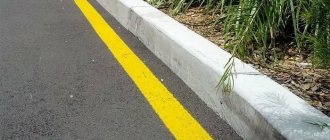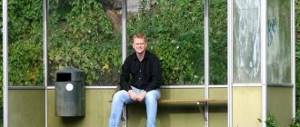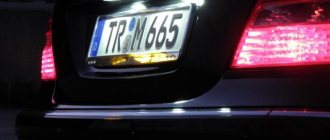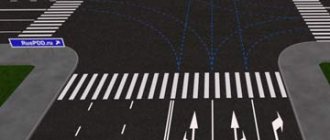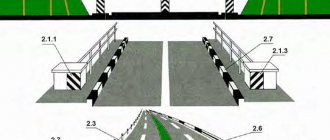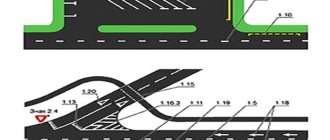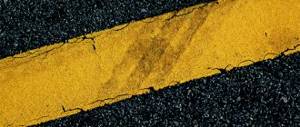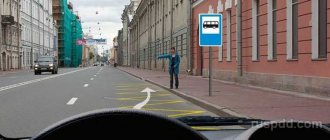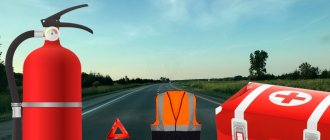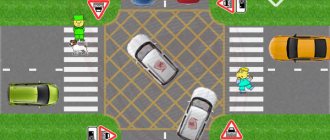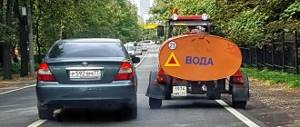Traffic rules exist to help citizens preserve their lives and health when moving along city streets. Changes are made to the regulatory list every year, and it can be difficult to keep up with all the trends. Therefore, today we will talk about yellow markings, so that everyone can become familiar with their purpose and reduce the number of possible mistakes on the road. Road safety is the joint work of all participants and the personal responsibility of everyone. This article will familiarize users with the rules and restrictions of yellow horizontal road markings, which are more common than the 50 circle sign on the road.
Yellow markings on the road - why they are needed
Don't be afraid when you have to drive where there are yellow markings on the road. We must remember that the rules are introduced for everyone’s safety, and not to complicate life. Having carefully studied the traffic rules, in particular, the meaning of these markings, everyone contributes to the development of a driving culture.
Double solid yellow markings
GOST has information that the white color is changing to yellow. This is done to improve visibility in winter. The value is no different from the white counterpart.
Single solid yellow marking
Multiple solid line values:
- separates moving traffic;
- in some cases it is used to limit traffic lanes in high-risk areas;
- used where traffic is prohibited;
- marks the location of areas intended for parking.
A solid stripe does not allow it to be crossed.
Single broken yellow marking
Separates moving vehicles. Intersects when it is necessary to overtake, turn or turn around. There is no broken line marking on the side of the road.
Marking 1.6 yellow
An increase in the length of the strokes and a decrease in the distance between them indicates that the broken line is coming to an end and a solid line will soon begin. Do not forget that in this case overtaking other vehicles is prohibited.
Double broken yellow markings
Located to indicate an area with reverse traffic. Such areas are regulated using special traffic lights.
Marking 1.11 yellow
Used in two cases:
- to separate traffic in one or the opposite direction in places where it is possible to change lanes only on one side;
- to show where it is allowed to move directly on the side where the broken line is located
The intersection is permitted to complete maneuvers such as overtaking and passing. Crossing from the side of the broken line is not prohibited.
Yellow markings on the road to prohibit stopping and parking
Located on the side of the road on the right, it says stopping and parking is prohibited. It is located either within the city along the curbs, or on intercity highways at the side of the road, along the edge of the road. In the place where the line is located, you cannot stop and park your car.
A broken yellow line along the side of the road indicates that parking is prohibited in that area only. You can make a stop within five minutes. Valid reasons include problems with transport, health, or other reasons that leave no other choice. Can be used with a "No Parking" sign. The principle of operation in this case is similar to that described above.
White and yellow pedestrian markings
Has no meaning other than white markings. It can be applied to both controlled and non-regulated pedestrian crossings.
Yellow zigzag markings on the road
Indicates places for public transport. Stopping is permitted only for boarding or disembarking passengers. Interference is not acceptable.
Waffle markings at an intersection
Applied to intersections for clarity. It is a square with a pattern resembling a wafer. It is prohibited to stop the vehicle. Makes it possible to understand whether it is possible to overcome the intersection if traffic ahead is difficult. If a controversial situation occurs, markings are used to determine whether there was a violation of traffic rules when crossing the intersection.
Yellow-white asphalt. Details of the introduction of new pedestrian crossings
The main point of the changes is to make transitions more noticeable. Allegedly, drivers will notice the approach of a dangerous section of the road earlier, and pedestrians will find it easier to find the zebra crossing.
Draft new standards were published on the official websites of the State Traffic Safety Inspectorate and Rosstandart, and anyone could offer their ideas for adjusting and finalizing this document. As a result, the developers received about 60 comments and suggestions, some of which were accepted. There were six main innovations left in the final version.
The main change is that the zebra crossing will now be white and yellow, and every crossing within the city limits will have to be equipped with a speed bump. However, there are still few specifics about how the new standards will be applied in Barnaul and the Altai Territory.
Infographic: The New Standard for Pedestrian Crossings
Mikhail Khozyaykin
No one will redo existing pedestrian crossings en masse yet. As Vladimir Shimko, head of the department of road inspection and traffic management of the State Traffic Safety Inspectorate in the Altai Territory, clarified, the use of new standards is not mandatory, but voluntary. Now design organizations will be recommended to use them. This means that most of the crossings that are organized or reconstructed after this winter will look in accordance with the new requirements.
It is unknown whether road workers will apply a zebra crossing on a yellow background when updating the markings annually. The Barnaul administration has not yet announced such plans. How this will happen at the regional level is also not entirely clear. “At the moment, this issue is under consideration,” says Nikolai Alexandrov, head of the technical supervision, repair and maintenance department of Altaiavtodor roads. — New standards will definitely be implemented, but to what extent has not yet been determined. Now experts are studying this issue and preparing their proposals.”
Pedestrian crossings will be brought into line with current changes in standards in the regional capital “gradually, based on traffic conditions and financing,” said Pyotr Gladyshev, chairman of the Committee for Road Facilities, Improvement, Transport and Communications of the Barnaul Administration. According to him, signs on reflective boards will be installed in 2014 at existing and newly constructed crossings near educational institutions and in areas with high traffic intensity.
In addition, zebra crossings must be equipped with stationary outdoor lighting. The city authorities expect to do this with the help of the “Bright City” street lighting development program, adopted before 2017. But again with a caveat - “based on the provided volumes of funding.”
Evgeny Smirnov, vice-president of the Altai Motorsport Federation, winner of the international rally "Beijing - Paris":
What is being done is wonderful, these are changes for the better, but this is only one side of the coin. And another, no less important, is education. Now, unfortunately, our pedestrians are oriented incorrectly. And the majority of them think: if he put his foot on the zebra crossing, then everyone should stop immediately. But no one has canceled the laws of physics; cars cannot stop abruptly. And it is not for nothing that the rules say that a pedestrian must make sure that the crossing will be safe for him. Unfortunately, there is no emphasis on this in propaganda. This is where all the problems come from. And they told him that he was in charge at the crossing, so he went. Moreover, they began to extend this rule to places outside the crossings. He went - that’s it, everyone “stop and be afraid.”
Another problem: often there are signs near the school, but then they are overgrown with bushes and tree branches. In winter, after snowstorms, the sign may be covered for several days. And no one cares - neither the school director, nor the head teacher. Although the price is: go out with a brush and sweep the sign.
And since our schools are stationary objects, the markings near them could be applied not with paint, which needs to be renewed twice a season, but with special plastics or tapes that are glued to the road surface. I have talked about this many times with those who are involved in developing our roads and applying markings. Their answer is very simple: “It’s easier for us.” Of course, plastic or tape is more expensive than paint, but they will last longer, at least two to three years. And the costs will ultimately be lower.
What requirements already exist for zebra crossings?
Pedestrian crossings in populated areas are located at intervals of 200–300 m. In towns or villages less than half a kilometer in length, no more than two pedestrian crossings are arranged at intervals of 150–200 m.
Outside populated areas, surface pedestrian crossings must be visible from both sides of the road at a distance of at least 150 m.
On roads with a carriageway width of 15 m or more, surface pedestrian crossings must be equipped with traffic islands.
Sign 1.22 “Pedestrian crossing” is installed outside populated areas in front of all unregulated ground crossings, and in populated areas - in front of crossings whose visibility distance is less than 150 m.
Signs 5.19.1 and 5.19.2 “Pedestrian crossing” are used to designate places designated for pedestrians to cross the road. On roads with a dividing strip, the sign is also installed on it. It should be located no closer than a meter from the border of the transition.
The width of the zebra crossing is determined by the intensity of pedestrian traffic at the rate of 1 m for every 500 pedestrians per hour. However, it cannot be less than 4 m.
New standards for pedestrian crossings
- "Zebra" will be applied to a yellow background.
- Pedestrian crossing signs will now be installed on yellow-green reflective boards.
- At educational institutions, signs will be additionally equipped with a yellow flashing traffic light.
- A duplicate “Pedestrian Crossing” road sign must hang above roadways of four or more lanes.
- In populated areas, a speed bump will be installed in front of each pedestrian crossing (with the exception of main roads and streets).
- Warning road signs (for example, the “Children” sign) will be duplicated by road markings on each lane.
What fine can be applied
Violation of the rules requires punishment. A car is a vehicle of increased danger. Everyone should treat road traffic with maximum responsibility. This applies to both motorists and pedestrians.
There are several types of liability, depending on the violation:
- If you fail to comply with the rules related to solid or intermittent yellow markings, you must pay a fine of one and a half to three thousand rubles, depending on the region. Also, the car will have to be picked up from the impound lot, where it will be towed;
- ignoring a pedestrian crossing or obstructing the movement of pedestrians is punishable by a fine of 500 rubles;
- if you leave the vehicle at a short distance from a stop or pedestrian crossing, you will have to part with an amount of one to three thousand rubles. In addition, you will also have to visit the impound lot to pick up the towed car;
- It is prohibited to move backwards or turn around at a pedestrian crossing. This creates a danger to the life and health of pedestrians. In this case, you will have to pay 500 rubles.
- Overtaking other road users at a pedestrian crossing is punishable in the most severe way - you will have to pay five thousand rubles or lose the ability to drive a car for a period of 4 to 6 months. In the event of a repeated incident, this time doubles.
Stones across the stream
The fact is that in Ancient Greece, in Roman, as well as in medieval cities, paved roads had similar structures designed for people to cross the streets. In those days, watercourses for the city storm sewer were built along the pavement. During heavy rains, streams of water from the roofs drained onto the pavement and connected on city roads. The pavement turned into a stream, which could only be crossed by special stones rising above the pavement by about one foot (30 cm). These stones had an oblong quadrangular shape. They were placed at a distance of approximately 70 cm from each other, that is, the width of a human step. Most often, alternating stones were located at road intersections.
These stones were located in such a way that horses and cart wheels passed by them, making it difficult to cross at high speed and the drivers squeezed through the stones. Such crossings were made in many cities of southern Europe and functioned for centuries.
Similar structures were built on shallow rivers.
Question answer
Can a cyclist ride on a pedestrian crossing?
TYPES OF YELLOW MARKINGS
1. “Single yellow solid line” is a slang name for road markings 1.4. It is applied at the edge of the roadway, along the top of the sidewalk curb (or on the edge of the sidewalk) parallel to the roadway.
This marking prohibits stopping and parking of vehicles at the place of application.
Drivers of route vehicles must remember: if in some cases they can ignore a sign prohibiting stopping, then with markings such an exception to the rules does not apply. Stopping (and automatic parking) is prohibited for vehicles (except for special vehicles).
The application of a “single yellow solid” can be combined with the installation of a “No Stopping” sign (3.27).
In this case, the coverage area of this sign will end at the point where the markings ended: the markings have ended - the sign has ceased to operate.
So, let’s draw the second conclusion: marking 1.4 at the place of application prohibits stopping and parking of the vehicle.
2. “Single yellow dashed line” - this is what the driving fraternity calls marking 1.10. It, like marking 1.4, is applied along the edge of the roadway, along the top of the sidewalk curb (or, in fact, on the edge of the sidewalk) parallel to the roadway.
This marking strictly prohibits parking of vehicles in the area where it is applied.
But remember that it allows the vehicle to stop. The driver can stop in the area where the “single yellow intermittent” is applied for up to 5 minutes or more, if at the same time he is loading and unloading people or loading and unloading vehicles.
“Single yellow intermittent” is used in parallel with the installation of a “No parking” sign (3.28).
The coverage area of the sign in this case is limited to the place where the marking is applied.
So, let’s draw the third conclusion: marking 1.10 at the place where it is applied prohibits parking of the vehicle, but allows stopping.
3. “Single yellow broken” marking line (1.17) indicates a section of the road where a stop for route vehicles (buses, trams, trolleybuses) or a parking lot for passenger taxis is organized.
Remember that it is prohibited to stop and park vehicles in such areas and 15 meters before and after them (with the exception of stopping for the purpose of boarding and disembarking passengers and provided that there is no interference with route vehicles).
In addition, at the location of route vehicle stops it is prohibited to do the following:
- turn;
- movement using reverse gear.
In such areas, which are located in populated areas, the driver is obliged to give way to route vehicles leaving the designated stop.
So, let’s make the fourth conclusion : in places where the “yellow broken line” is applied, turning around, reversing, and stopping and parking a vehicle are prohibited (except for stopping to pick up and unload passengers, when no obstacles are created for route vehicles).
YELLOW ZEBRA MARKINGS
To improve the visibility of a pedestrian crossing and increase safety when driving through such areas, to reduce slipping on them, markings in the form of alternating yellow stripes, similar to white zebra stripes (markings of the 1.14 family, indicating a pedestrian crossing), are used as an additional component.
“Yellow zebra” (more precisely, “white-yellow zebra”) is applied to any pedestrian crossing: both regulated and unregulated. The color yellow encourages drivers to increase their vigilance at crossings and be especially careful.
It will not be amiss for the driver to remember that, in accordance with sections 8, 11, 12, 13,14 of the Traffic Regulations, he is held responsible when driving through a pedestrian crossing. These requirements are beyond the scope of our consideration, so it is better to make a link to a special material on the topic “Actions of the driver when passing a pedestrian crossing.”
So, let's make the fifth conclusion : in places where the “yellow zebra” is applied, the driver must remember to be responsible when driving through a pedestrian crossing. The additional yellow color of the zebra indicates the peculiarity of such a crossing - increased traffic intensity of the crossing or other complexity.
What is the fine for yellow markings?
If the driver manages to stop on the yellow solid line 1.4 or even cross it, then he falls directly under Article 12.9 of the Code of Administrative Offenses “Violation of the rules for stopping or parking a vehicle.” The fine for this is 500 rubles, but in Moscow and St. Petersburg it is already 2,500.
In general, my opinion: traffic rules are gradually turning into a project for making money. Each point is a new way to confuse the driver, provoke him into committing a violation and incur a fine.
Do you agree with me?
ADMINISTRATIVE RESPONSIBILITY OF THE DRIVER FOR VIOLATION OF YELLOW MARKINGS
Let’s make a reservation right away: we will not touch upon the criminal and civil types of liability of the driver, but will focus on the “driver’s” responsibility itself - administrative liability for violating yellow markings.
- Violation of the requirements for markings “single yellow solid” and “single yellow intermittent” entails an administrative fine of 1,500 rubles, and in St. Petersburg and Moscow – 3,000 rubles. In addition, the vehicle is detained and placed in an impound lot.
- For failure to give priority to a route vehicle when it leaves a “single yellow broken” marking – a fine of 500 rubles.
- For failure to provide an advantage to pedestrians moving along a yellow zebra crossing - a fine of 1,500 rubles.
- For violating the rules of stopping and parking within the “yellow zebra” and “single yellow broken line” - a fine of 1000 rubles, and in St. Petersburg and Moscow - 3000 rubles. In addition, the vehicle is delayed from being placed in the impound lot.
- For violating the rules of turning and reversing on a “yellow zebra crossing” and within a “single yellow broken line” - a fine of 500 rubles.
- For violating the rules of overtaking on a yellow zebra crossing - a fine of 5,000 rubles. or deprivation of a driver's license for 4-6 months. In case of repeated violation - deprivation of driving license for 12 months or a fine of 5,000 rubles.
So, let’s make the sixth conclusion : the driver’s administrative responsibility for violating yellow markings varies (depending on the severity of the offense committed) from a fine of 500 rubles. up to a fine of 5,000 rubles. or deprivation of driver's license for up to 1 year.
